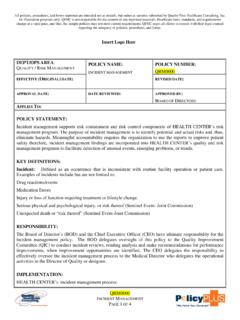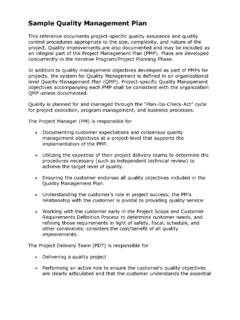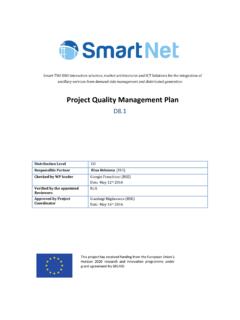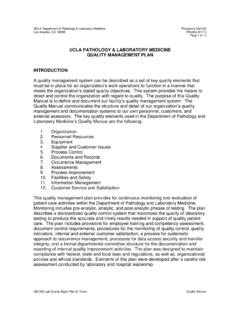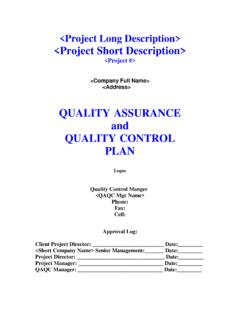Transcription of Healthcare Organization Quality and Risk Management Plan …
1 All policies, procedures, and forms reprinted are intended not as models, but rather as samples submitted by Quality First Healthcare Consulting, Inc. for illustration purposes only. QFHC is not responsible for the content of any reprinted materials. Healthcare laws, standards, and requirements change at a rapid pace, and thus, the sample policies may not meet current requirements. QFHC urges all clients to consult with their legal counsel regarding the adequacy of policies, procedures, and forms. QRM0000 Quality & RISK Management plan PAGE 1 OF 19 Insert Logo Here Healthcare Organization Quality and Risk Management plan 2015 Reviewed by the Quality Improvement Committee Date: _____ Approved by the Board of Directors Date: _____ QRM0000 Quality & RISK Management plan PAGE 2 OF 19 Community Health Center Quality and Risk Management plan I. PHILOSOPHY & PURPOSE: Community Health Center (CHC) develops and implements policies and procedures that insure continuous measurable Quality improvement in patient care, CHC clinical processes, risk Management and patient safety, efficiency and effectiveness of clinical services and Management , community and financial accountability.
2 Policies and procedures are designed to directly support CHC s Mission, Values and Strategic plan . CHC s Quality Improvement/ Quality Assurance (QI/QA) and risk Management (RM) procedures are imbedded in the day-to-day operations of CHC, involve all staff, and contribute to a culture of clinical and operational excellence. QI/QA and RM performance measures address clinical services and Management , Quality of care and services, patient access, patient experience, health care costs, care coordination, compliance, network Quality , adverse events, utilization of services. QA/QI activities will incorporate those measures/ standards required by insurers, funders, and regulators. CHC will include the elements required for FTCA qualification and meaningful use of our EHR. In addition, QA/QI will provide measures of excellence to justify third party Quality recognition. QA/QI will support CHC to move toward Patient-Centered Medical Home accreditation offered by HRSA in partnership with the NCQA.
3 We aspire to be compliant by design while individualizing the QI/QA process to meet our unique needs. CHC wishes to measure progress toward/success meeting the Triple Aim of improving the health of our community, patient satisfaction and retention, and reducing the per capita cost of care. Doing so will support CHC s desire to move gradually from a fee for service model to a population based reimbursement model. II. Guiding Principles Quality Improvement/ Quality Assurance: The key attributes that support CHC s vision of a health delivery system describes a system that promotes excellence if patient safety, risk prevention and Management , Quality care and services. This system is: Is centered upon treating people with dignity Focuses on patient-centered care Provides an integrated continuum of care Demands service excellence Focuses on the triple aim concepts of improving patient care, improving the patient experience, and reducing costs Requires effective communication and information sharing Continually improves its operating and clinical practices Integrate with risk Management principles and practice QRM0000 Quality & RISK Management plan PAGE 3 OF 19 Is best achieved by teamwork Uses resources optimally Is scientific and results oriented Provides a safe environment for clients, visitors, and staff Delivers care based on the best scientific evidence combined with judgment of expert clinicians Risk Management : RM is an overarching, conceptual framework that guides the development of a systematic approach to Management of risk Management and patient safety initiatives and activities.
4 The plan is operationalized through a formal, written risk Management and patient safety plan . RM activities support CHC s philosophy that patient safety and risk Management is everyone s responsibility. Teamwork and participation among Management , providers, volunteers, and staff are essential for an efficient and effective patient safety and risk Management program. The program will be implemented through compliance with all policies relevant to patient safety and risk Management , the coordination of multiple organizational functions and the activities of multiple departments. CHC supports the establishment of a just culture that emphasizes implementing evidence-based best practices, learning from error analysis, and providing constructive feedback, rather than blame and punishment. In a just culture, unsafe conditions and hazards are readily and proactively identified, medical or patient care errors are reported and analyzed, mistakes are openly discussed, and suggestions for systemic improvements are welcomed.
5 Individuals are still held accountable for compliance with patient safety and risk Management policies and practices. As such, if evaluation and investigation of an error or event reveal reckless behavior or willful violation of policies, disciplinary actions can be taken. Through RM CHC stimulates the development, review, and revision of the Organization s policies, practices and protocols in light of identified risks and chosen loss prevention and reduction strategies. Principles of CHC s RM provide the foundation for developing key policies and procedures for day-to-day risk Management activities, including: Claims Management Complaint resolution Confidentiality and release of information Event investigation, root-cause analysis, and follow-up Failure mode and effects analysis Referral Management Infection Control Clinical supervision and back-up of clinical and non-clinical staff Provider and staff education, competency validation, and credentialing requirements Reporting and Management of adverse events and near misses Trend analysis of events, near misses, and claims QRM0000 Quality & RISK Management plan PAGE 4 OF 19 III.
6 Quality and Risk Management Structure A. Scope and Key Functions The Quality and Risk Management (QRM) program is multi-disciplinary and involves clinicians, clinical support staff across all service areas, allied health disciplines, community service agencies as appropriate, administrators, managers, and others that provide care or services to the population we serve. The program focuses on improving key client and organizational functions within CHC. The key functions are assessed by collecting and analyzing data related to one or more dimensions of performance, which includes but may not be limited to efficacy, appropriateness, availability, timeliness, effectiveness, continuity, safety, efficiency, and respect and caring. The key functional areas within the scope of the CHC QRM Program are: 1. Population Health Management (Care Management ) biological, social, and/or Quality of life consequences of clinical and social evaluation and Management of care and services in areas such as preventive health, acute or chronic conditions, high risk/complex, and behavioral health 2.
7 Patient Safety capabilities to promote a safe environment for clients by evaluation in areas such as client and provider education, policy and procedures, continuity and coordination of care 3. Access and Availability capabilities and effectiveness in providing appropriate access during and after hours. 4. Network Quality periodic peer review assessments of client records by physicians or by other licensed health professionals under the supervision of physicians of the appropriateness of the utilization of services and the Quality of services provided or proposed to be provided to individuals served; capabilities, satisfaction, accessibility and availability of Healthcare and human services, including monitoring and evaluation of Quality of care/ Quality service complaints, credentialing/recredentialing, and adverse occurrence tracking 5. Client Satisfaction-ability to meet the needs of CHC customers 6. Customer Service capabilities, satisfaction, accessibility of the provision of customer service.
8 Specific risk Management functional responsibilities that integrate with the above functional areas include: Developing systems for and overseeing the reporting of adverse events, near misses, and potentially unsafe conditions. Reporting responsibilities may include internal reporting as well as external reporting to regulatory, governmental, or voluntary agencies. This includes the development and implementation of event-reporting policies and procedures. Ensuring the collection and analysis of data to monitor the performance of processes that involve risk or that may result in serious adverse events ( , preventive screening, diagnostic testing, medication use processes, perinatal care). Proactive risk assessment can include the use of failure mode and effects analysis, system analysis, and other tools. QRM0000 Quality & RISK Management plan PAGE 5 OF 19 Overseeing the Organization s systems for data collection and processing, information analysis, and generation of statistical trend reports for the identification and monitoring of adverse events, claims, finances, and effectiveness of the risk Management plan .
9 This system may utilize and include, but is not limited to, the following: Attorney requests for medical records, x-rays, laboratory reports Committee reports and minutes Criteria-based outcome studies Event, incident, or near miss reports Medical record reviews Monitoring systems based on objective criteria Notice letters, lawsuits Patient complaints Physician and other medical professionals input Results of failure mode and effects analysis of high risk processes Root-cause analyses of sentinel events Analyzing data collected on adverse events, near misses, and potentially unsafe conditions; providing feedback to providers and staff; and using this data to facilitate systems improvements to reduce the probability of occurrence of future related events. Root-cause analysis and systems analysis can be used to identify causes and contributing factors in the occurrence of such events. Ensuring compliance with data collection and reporting requirements of governmental, regulatory, and accrediting agencies.
10 Facilitating and ensuring the implementation of patient safety initiatives such as improved tracking systems for preventive screenings and diagnostic tests, medication safety systems, and falls prevention programs. Facilitating and ensuring provider and staff participation in educational programs on patient safety and risk Management . Facilitating a culture of safety in the Organization that embodies an atmosphere of mutual trust in which all providers and staff members can talk freely about safety problems and potential solutions without fear of retribution. Proactively advising the Organization on strategies to reduce unsafe situations and improve the overall environmental safety of patients, visitors, staff, and volunteers, as applicable. Reducing the probability of events that may result in losses to the physical plant and equipment ( , biomedical equipment maintenance, fire prevention). Preventing and minimizing the risk of liability to the Organization , and protecting the financial, human, and other tangible and intangible assets of the Organization .
